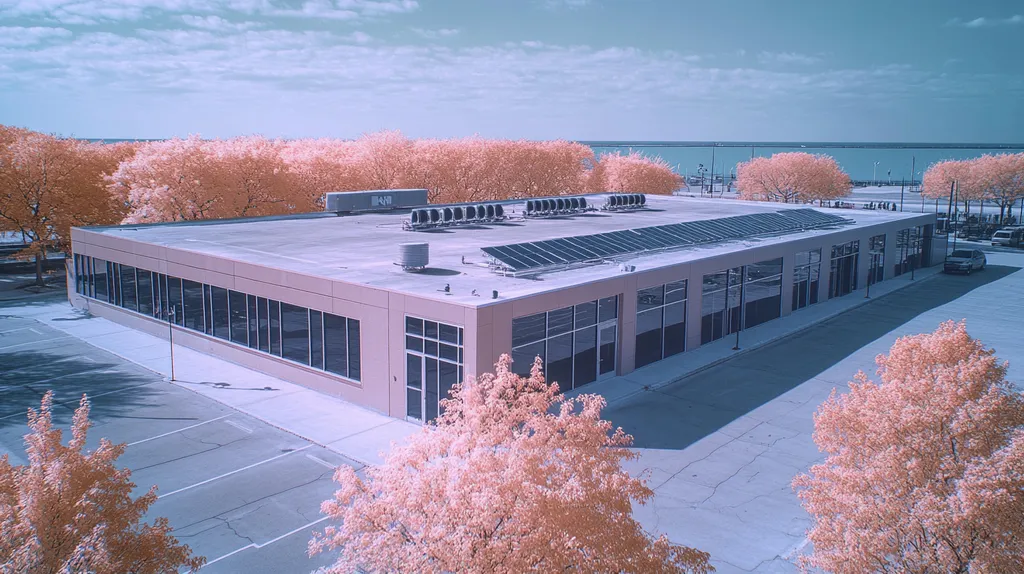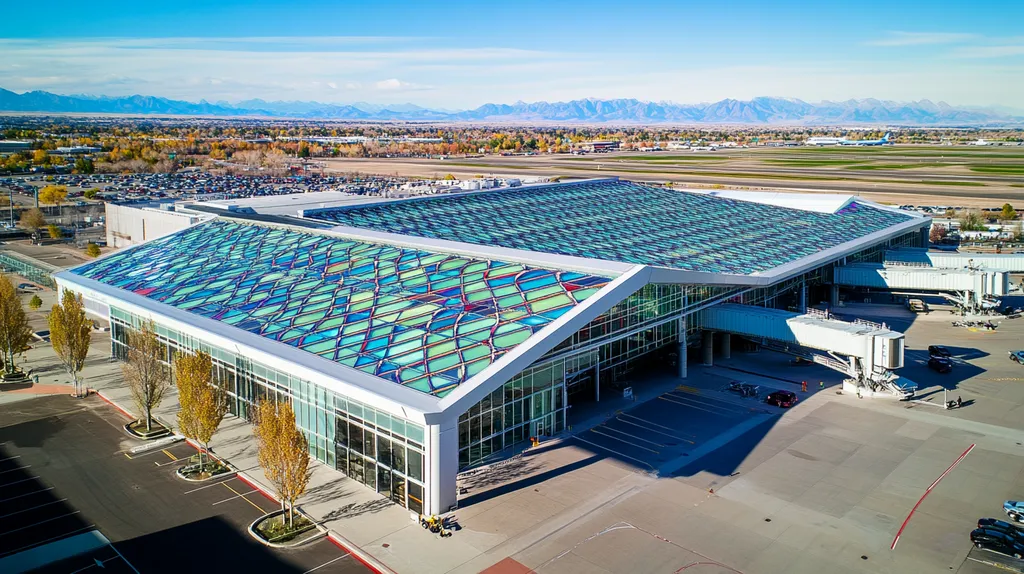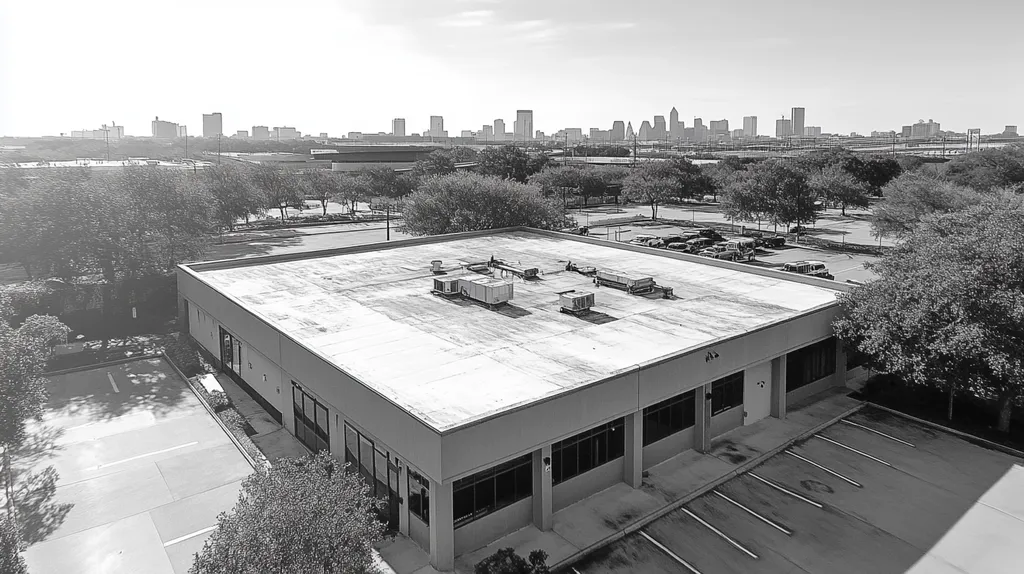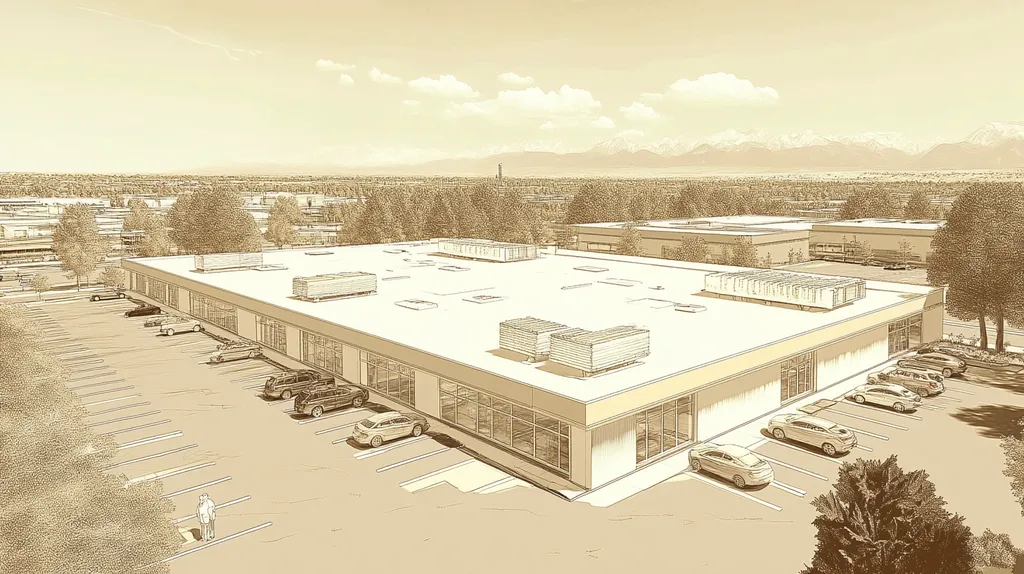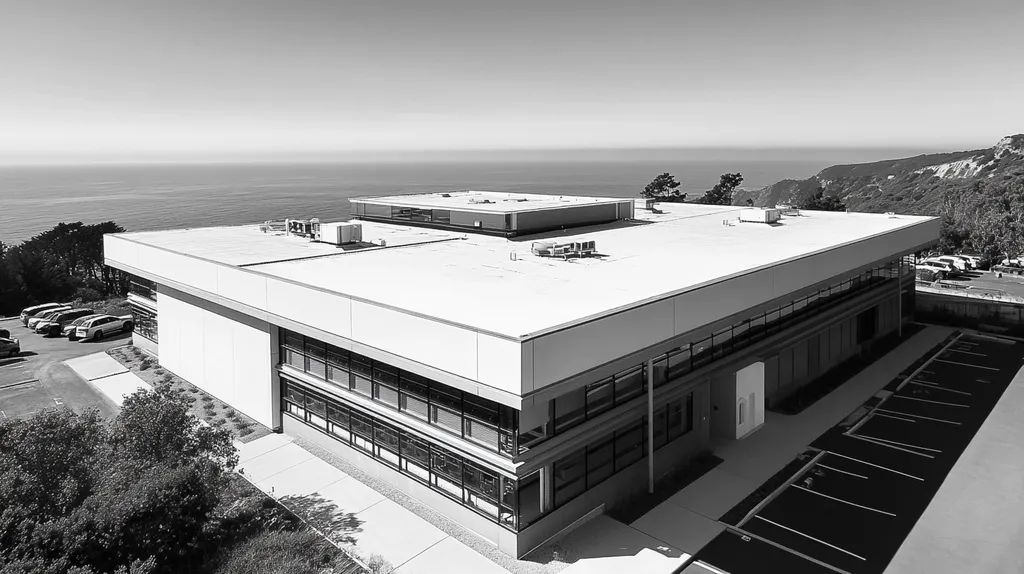Water damage from ineffective commercial roof drainage costs U.S. businesses over $13 billion annually in repairs and lost productivity. Studies show that 65% of all roof failures stem from poorly maintained or improperly sized gutter systems.
For facility managers, optimizing gutter performance represents a critical yet often overlooked opportunity to protect assets and reduce operating costs. Modern drainage solutions can extend roof life by up to 40% while significantly decreasing maintenance expenses.
This comprehensive guide examines the key factors in commercial gutter system optimization – from performance metrics and financial considerations to compliance requirements and risk management protocols – providing actionable solutions for enhanced building protection.
SECTION 1: PERFORMANCE FACTORS
Effective roof drainage is not just a maintenance issue; it’s a critical safeguard against water damage that can disrupt operations and incur hefty repair bills. In fact, the National Roofing Contractors Association highlights that inadequate drainage systems are a leading cause of roof failures. For facility managers, grasping the key performance factors of gutters—like their water flow capacity, mechanisms for debris accumulation prevention, and overall drainage efficiency—is essential to preserving the integrity of their properties. This section delves into these factors, outlining their importance for a reliable gutter system.
Water Flow Capacity
Water flow capacity directly impacts how well a gutter system performs. This term refers to the volume of water a gutter can manage during heavy rainfall without spilling over. Facility managers must ensure their gutters are correctly sized to handle the maximum water flow that storms can produce.
For example, while a standard commercial gutter may manage a specific volume of rainwater, sudden heavy downpours can easily exceed those expectations. Overflowing gutters can lead to water pooling on the roof, which poses risks of structural damage and increases the likelihood of leaks.
Furthermore, improper sizing is often due to outdated building codes or subpar installation. Regular assessments can pinpoint whether existing gutter systems are adequate for evolving weather patterns. Working with roofing professionals can help facility managers evaluate and enhance their gutter systems for optimal water flow capacity.
Key Action Items
Debris Accumulation Prevention
Debris buildup is a common challenge that can severely disrupt gutter functionality, leading to improper drainage and subsequently, water overflow. Leaves, dirt, and even twigs can create blockages, transforming gutters from pathways for water into unintended barriers. This stagnation can result in roof decay and increased maintenance headaches.
To tackle this issue, investing in gutter guards or screens can be a game-changer. These protective systems prevent debris entry, allowing for smooth water flow. However, depending on your location, regular cleanings might still be necessary, particularly during seasonal changes.
Facility managers should also consider their building’s surroundings, as those near trees will face higher debris accumulation than those in open areas. Understanding these dynamics allows for a tailored debris management strategy that promotes longevity for the roof system.
Key Action Items
Drainage Efficiency
Drainage efficiency is a vital measure of how effectively a gutter system can channel water off the roof and into the designated drainage areas. High drainage efficiency is crucial for preventing water accumulation, which can lead to extensive structural issues over time.
A key aspect of efficient drainage is the design and installation of gutter slope. If the slope is too flat, it can result in stagnant water, while an excessive slope may lead to rapid water runoff without proper collection. Striking that ideal balance is imperative for effectiveness.
Conducting regular inspections can help identify misalignments or blockages hindering drainage efficiency. Facility managers should consider scheduling assessments, particularly after heavy rain, to evaluate the performance of the system and take prompt corrective actions.
Key Action Items
SECTION 2: FINANCIAL CONSIDERATIONS
Recognizing the financial implications of gutter systems in commercial roofing is essential for facility managers and property owners. A subpar gutter design or neglect in maintenance can escalate repair costs and jeopardize the structural integrity of the building. Research indicates that effective drainage systems can slash water damage by up to 85%, making a solid financial case for investing in quality gutter solutions. This section will break down the associated installation costs, maintenance expenses, and the potential for significant long-term savings.
Initial Installation Costs
The initial costs for installing a gutter system can vary widely based on the roof’s size and complexity. Generally, opting for high-quality materials like aluminum or stainless steel might incur higher upfront costs, but their durability often compensates for this through reduced long-term expenses.
Viewing these costs as an investment is crucial. An appropriate gutter system effectively prevents water accumulation that could lead to severe damage, thereby minimizing future repair spending.
Additionally, the geographical location of the building plays a role; regions with heavier rainfall may warrant sturdier systems, impacting upfront costs. Choosing a quality gutter solution can save facility managers money and extend the lifespan of the roof over time.
Key Action Items
Maintenance and Repair Expenses
Regular maintenance and repairs for gutters can accumulate if not properly managed. Consistent inspections and cleanings are vital to prevent blockages that may lead to overflow and significant water damage.
Inefficient gutter maintenance may result in ballooning repair costs affecting the foundation, walls, and roof of the building. Statistics show that the repair costs from neglect can reach five times the original installation cost.
By budgeting for routine maintenance, facility managers can mitigate potential risks. A proactive approach in this area means that small investments in upkeep can protect against unexpected expenses in the future.
Key Action Items
Long-Term Cost Savings
Investing in efficient gutter systems can secure significant long-term savings for property owners. When gutters function correctly, they protect the building’s integrity, substantially lowering the risk of costly water damage repairs.
Moreover, high-quality drainage systems contribute to enhanced energy efficiency of the structure. By minimizing moisture-related issues, property managers can experience reduced energy bills along with decreased repair expenses.
Research indicates that buildings featuring well-maintained drainage systems significantly lower mold and mildew growth, which further helps avoid health-related costs. Understanding these long-term benefits empowers facility managers to prioritize investment in effective gutter systems.
Key Action Items
SECTION 3: COMPLIANCE REQUIREMENTS
Meeting compliance standards for commercial roof drainage systems is critical for effective facility management. Non-compliance can result in serious consequences, from extensive structural damage to hefty fines. Statistics reveal that neglecting proper drainage guidelines increases the risk of leaks, mold growth, and even catastrophic roof failures. Understanding required standards and best practices helps protect assets while ensuring operational continuity.
Building Code Adherence
Building codes set the foundational requirements for gutter systems in commercial buildings and vary by location. These codes typically specify necessary dimensions, slope angles, and material types. Compliance is essential for proper water management and minimizing potential damage caused by excess water.
Many jurisdictions stipulate that gutters must manage particular volumes of rainwater based on the roof’s area and local precipitation patterns. Failing to comply can lead to structural failures or safety hazards within the community. Conducting regular inspections is vital to maintain adherence to these codes.
Facility managers need to stay informed about the latest building codes and promptly adjust their systems as changes arise. This vigilance not only safeguards buildings but also helps avoid penalties for non-compliance. Proper documentation during gutter installation is crucial for any future inspections.
Key Action Items
Regulatory Standards
In addition to building codes, various regulatory agencies impose standards affecting commercial gutters. Organizations like the Occupational Safety and Health Administration (OSHA) and the Environmental Protection Agency (EPA) set regulations that are vital for roofing systems. Understanding and adhering to these standards helps mitigate potential legal risks.
For instance, guidelines for rainwater management ensure facilities do not pollute local waterways. Discharging untreated runoff can lead to heavy fines or even shutdowns. Recognizing the connection between gutter systems and regulatory compliance is essential for facility managers.
Moreover, drainage systems often need to align with energy efficiency and sustainability standards. This can involve stormwater management practices, compelling installations of green roofs or water reclamation systems. Keeping abreast of these regulations requires ongoing education and engagement with appropriate agencies.
Key Action Items
Industry Best Practices
Following industry best practices enhances both gutter performance and regulatory compliance. Routine maintenance, regular inspections, and timely upgrades align with current advancements in gutter technology, preventing common issues like blockages and overflow that can lead to deterioration.
Employing high-quality materials and techniques designed for superior performance not only extends the lifespan of gutter systems but also promotes efficiency. Facility managers should prioritize these recommended practices to ensure systems operate optimally.
Additionally, integrating technology can significantly improve compliance. Modern monitoring systems, including sensors and digital documentation tools, simplify compliance management. These technologies provide timely alerts for maintenance needs, ensuring roofs remain protected.
Key Action Items
SECTION 4: RISK MANAGEMENT
Effective gutter systems are crucial for managing risks associated with commercial roofing. Water damage is more than just an inconvenience; it can lead to hefty repair costs and disrupt business operations. Studies reveal that ineffective drainage can inflate roofing repair expenses by nearly 30%. This section explores three main areas of risk management: water damage mitigation, structural integrity protection, and liability reduction.
Water Damage Mitigation
Water accumulation from malfunctioning gutters can severely damage commercial buildings. Standing water can seep into roofing materials, shortening their lifespan, while encouraging mold growth, which poses health risks and inflates maintenance costs. Regular gutter inspections are essential for identifying and clearing debris to prevent overflow and water pooling.
Establishing a routine maintenance schedule will significantly reduce the likelihood of water damage. High-quality, corrosion-resistant gutter materials enhance drainage and durability, minimizing failures that lead to costly renovations. Additionally, ensuring proper downspout placement effectively channels water away from the foundation, providing extra protection against potential damage.
Key Action Items
Structural Integrity Protection
Neglecting gutter maintenance risks compromising a building’s structural integrity. Excessive water can erode foundations, causing cracks that threaten stability. Facility managers must frequently monitor gutters to ensure they effectively divert water away from vulnerable areas.
Evaluating gutter slope and positioning is key for optimal drainage. Any improper angle can result in water accumulation, escalating into significant structural issues. Additionally, installing structural reinforcements in high-stress areas helps protect gutters against the destructive impacts of storm debris.
Key Action Items
Liability Reduction
Water-related damage can expose facility managers to significant legal liabilities. If water intrusion results in injuries on the property, the likelihood of lawsuits increases substantially. Regular maintenance of gutter systems plays a vital role in creating a safer environment for employees and visitors.
Maintaining detailed documentation of all maintenance activities acts as essential proof in any liability claims. Ensuring thorough records of inspections and repairs demonstrates the facility’s commitment to safety and due diligence. Furthermore, effective drainage reduces the risk of accidents caused by water pooling on walkways.
Engaging with insurance providers regarding implemented gutter maintenance can lead to favorable policy terms. Demonstrating proactive risk management may result in lower premiums and enhanced coverage options, reflecting sound stewardship of commercial properties.
Key Action Items
SECTION 5: OPERATIONAL PROCEDURES
Effective management of commercial roof drainage systems requires well-defined operational procedures. Ignoring gutter care can lead to severe water damage, deteriorating roofs, and costly repairs. Data shows that improper maintenance can cut a gutter system’s lifespan by as much as 50%. This section emphasizes the critical importance of establishing regular inspection schedules, thorough cleaning and maintenance protocols, and solid emergency response plans to safeguard valuable property investments.
Regular Inspection Schedules
Establishing a routine for gutter inspections is vital for maintaining system performance and longevity. Facility managers should aim to schedule inspections at least twice a year, ideally in the spring and fall. This proactive approach enables early detection of potential issues like clogs, leaks, and structural weaknesses.
It’s crucial to inspect not just the gutters but also downspouts and drainage outlets. Blockages or structural issues at these junctions can lead to significant problems if not addressed swiftly.
Documenting inspection findings and maintaining a tracking system can facilitate predictive maintenance strategies tailored to specific needs, ultimately saving costs over time. To ensure thorough evaluations, inspections should be conducted by trained personnel with the appropriate expertise.
Key Action Items
Cleaning and Maintenance Protocols
Robust cleaning and maintenance protocols are essential for the proper functioning of commercial gutters. The frequency of cleaning should be based on the facility’s environment; properties near trees may require quarterly cleanings while others may only need to clean them twice a year.
During each cleaning, all debris—such as leaves, dirt, and nests—must be thoroughly removed. Clogged gutters can lead to overflow, potentially damaging the roof and the building’s foundation.
Maintenance also involves checking for rust, corrosion, and signs of wear. Addressing these issues promptly helps extend the life of the gutter system. Additionally, installing gutter guards can reduce the buildup of debris, thereby minimizing cleaning frequency.
Key Action Items
Emergency Response Plans
Despite thorough maintenance practices, emergencies can occur, making an effective emergency response plan crucial for minimizing damage from sudden gutter failures. This plan should outline clear procedures for prompt action, ensuring personnel are prepared to handle issues like water overflow or gutter breaches.
Establishing relationships with emergency repair services ahead of time can expedite response during crises. Facility managers should compile a list of reliable local contractors who specialize in gutter repairs.
Training staff to recognize early signs of gutter failure—such as water stains or pooling—can substantially reduce damage. Regular drills or reviews of the emergency plan will ensure that all personnel understand their responsibilities, transforming potential crises into manageable situations.
Key Action Items
SECTION 5: OPERATIONAL PROCEDURES
Robust operational procedures are the backbone of effective management for commercial roof drainage systems. Failing to address gutter care can lead to devastating water damage, accelerated roof deterioration, and expensive repairs. Research shows that neglect can shorten the lifespan of a gutter system by up to 50%. This section underscores the urgent need for regular inspection schedules, thorough cleaning and maintenance protocols, and well-defined emergency response plans to safeguard valuable property investments.
Regular Inspection Schedules
Establishing a routine for gutter inspections is vital to maintain system performance and longevity. Facility managers should aim to schedule inspections at least bi-annually, ideally in the spring and fall. This proactive approach facilitates early detection of potential issues such as clogs, leaks, and structural weaknesses.
It is essential to inspect not just the gutters but also the downspouts and drainage outlets, as blockages or issues at these junctions can lead to significant problems. Documenting inspection findings and maintaining a tracking system helps enable predictive maintenance tailored to specific needs, saving costs in the long run.
To ensure thorough evaluations, inspections should be conducted by trained personnel with the required expertise. This ensures that all components are accurately assessed, reducing the risk of oversights that could result in costly water damage.
Key Action Items
Cleaning and Maintenance Protocols
Robust cleaning and maintenance protocols are essential for effectively managing commercial gutters. The frequency of cleaning should be tailored to the facility’s environment—properties located near trees may require quarterly cleanings, while others may only need bi-annual cleanings.
Each cleaning session should involve the thorough removal of all debris, including leaves, dirt, and nests. Clogged gutters can lead to overflow, which may cause damage not only to the roof but also to the building’s foundation.
In addition to cleaning, routine maintenance must include checks for rust, corrosion, and any signs of wear. Addressing these issues promptly can significantly extend the lifespan of the gutter system. Installing gutter guards can also serve as an effective preventive measure, reducing the likelihood of debris accumulation.
Key Action Items
Emergency Response Plans
Emergencies can arise even with diligent maintenance, making an effective emergency response plan essential for minimizing damage from sudden gutter failures. This plan should outline clear procedures for prompt action, ensuring personnel are prepared to address issues like water overflow or gutter breaches.
Developing relationships with emergency repair services in advance can facilitate prompt action during critical situations. Facility managers should compile a list of reliable local contractors specializing in gutter repairs.
Moreover, training staff to recognize early warning signs of gutter failure—such as water stains or pooling—can significantly reduce damage. Regular drills or reviews of the emergency plan ensure that personnel understand their roles, allowing for quick and effective responses.
Key Action Items
Looking Ahead
With water damage from inadequate drainage costing U.S. businesses over $13 billion annually, optimizing commercial gutter systems represents a critical priority for facility managers.
Modern drainage solutions can extend roof life by up to 40% while significantly reducing maintenance expenses through proper sizing, strategic material selection, and diligent maintenance protocols.
The integration of emerging technologies, from smart sensors to advanced materials, continues transforming how facilities approach gutter management and maintenance.
By implementing the comprehensive strategies outlined in this guide – from performance optimization and financial planning to compliance and risk management – facility managers can transform their drainage systems from potential liabilities into valuable assets that protect and enhance their properties.
The future of commercial roof drainage lies in proactive management, emerging technologies, and data-driven maintenance strategies.
FREQUENTLY ASKED QUESTIONS
Q. What are the key performance factors for commercial roof drainage?
A. The key performance factors include water flow capacity, debris accumulation prevention, and drainage efficiency. Understanding these factors helps in ensuring that gutters efficiently manage rainwater, preventing leaks and roof damage. Regular assessments and expert consultations can enhance the gutter system to meet evolving weather demands.
Q. How can financial considerations impact commercial roof maintenance?
A. Financial considerations like initial installation costs and maintenance expenses play a crucial role. Investing in quality materials can prevent future costly repairs due to water damage. By budgeting for effective drainage systems, facility managers can achieve significant long-term savings, making it a smart financial decision.
Q. What compliance requirements should be considered for industrial roofs?
A. Compliance requirements include adherence to local building codes and regulatory standards. Maintaining compliance protects facilities from structural issues and fines. Regular inspections and documentation of gutter systems are essential to ensure they meet legal and safety obligations.
Q. How does gutter maintenance contribute to risk management?
A. Proper gutter maintenance mitigates risks like water damage and structural integrity loss. By ensuring effective drainage, facility managers can reduce liabilities related to water-related injuries or property damages. Diligent documentation of maintenance activities also protects against potential legal claims.
Q. What operational procedures should be in place for commercial gutters?
A. Key operational procedures include regular inspection schedules, thorough cleaning routines, and emergency response plans. These procedures ensure that any issues are identified and addressed promptly, maintaining the efficiency and longevity of the gutter system while minimizing potential damage.
Q. How often should commercial gutters be inspected?
A. Commercial gutters should ideally be inspected at least twice a year, in spring and fall. Regular inspections help detect potential issues such as clogs, leaks, or structural weaknesses before they escalate into costly repairs, contributing to effective maintenance.
Q. What technology can enhance gutter management on industrial roofs?
A. Modern technology includes monitoring systems that use sensors to detect gutter performance in real time. These advancements provide alerts for maintenance needs, improving compliance with regulations and ensuring that the gutter system operates optimally, ultimately protecting the facility.

